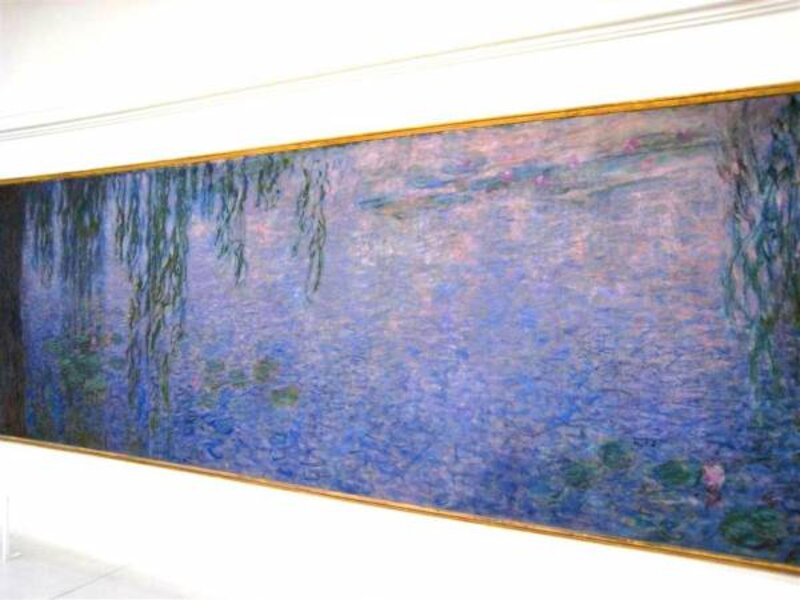Seeing water in the garden as Monet did
Loading...
Thoughts on water and gardening are never far from my mind, even when I’m traveling in winter. One of the highlights of my recent three-week visit to Paris was a tour of the Orangerie Museum, specifically the two rooms that feature Claude Monet's enormous wall-long paintings of waterlilies, Nymphaea.
The Orangerie itself was originally built for horticulture — designed in 1852 as winter storage for the Tuileries Gardens’ citrus trees.
I stood in an interminable line that snaked into the gardens from the front door. Note to travelers — museums in Paris during the December holidays are crowded, same as in summer — but the folks in line are Europeans, not Americans.
I debated whether the wait was worth it — the movement forward was infinitesimal. After all, I’d seen other waterlily paintings. Monet made more than 40 on the same subject, his water gardens at Giverny. I’d seen Giverny and even gardens based on Giverny. What was I doing, standing in the bitter cold aftermath of an unusual Paris snowstorm?
But I waited. Every other time I’d been in Paris, the Orangerie had been closed and under construction for a remodel that would allow these eight paintings to be seen as Monet intended — washed in natural overhead illumination from skylights.
Finally, I made it into the oval rooms, shaped in the figure of a lemniscate, that form representing infinity. The curving walls are lined with Monet’s familiar subjects. But these last gigantic paintings, produced at the end of his life when he was going blind, are different from any of the other waterlily paintings I knew.
Here, there is no shoreline to be seen. Waterlilies still float — you could almost smell the scent of an astonishing magenta blossom, obviously a night-bloomer, glowing from the center of a dark canvas — but everything else familiar has been stripped away. There are no arching Japanese bridges, no flowers tumbling on the banks, and only the hanging tips of the iconic willow trees.
These works are about the essence of water. Water at sunrise. Water at sunset. Water with calm reflective surfaces, sun-pinked clouds hanging upside down.
But the painting that attracted me the most was the one of water riffled by wind.
My friend and colleague, garden photographer Robin Bachtler Cushman says that water is really difficult to photograph so that it looks like liquid. In photos, water tends to take on mass that makes it appear like concrete, especially when caught in motion.
Yet here I saw, as I sat down and studied the painting, was alluring depth. Like looking into a pond in nature — if I stared long enough, I might see through the moving reflective riffles to the bottom. It felt so wet, I could fall in — especially without any reference to the encircling banks of the pond.
Look close, or step back; you become aware of Monet’s process for delineating the water’s surface patterns — from artist’s eye to mind to brush to the painting’s canvas. Then the magic happens. It’s water. I reacted to it as if I were next to water outdoors — calm peace, and pleasure for the eye.
Afterward, standing on a wind-blown bridge over the winter-gray Seine, I noticed the river’s riffles there — the workday barges slapping through tiny steel-edged peaks. And just for a second I saw the water with the artist’s heightened awareness — pattern, surface, light play — my own brief glimpse at the far shore of long-gone greatness.
Mary-Kate Mackey is one of eight garden writers who blog regularly at Diggin' It. She is co-author of “Sunset’s Secret Gardens — 153 Design Tips from the Pros” and contributor to the “Sunset Western Garden Book,” writes a monthly column for the Hartley Greenhouse webpage and numerous articles for Fine Gardening, Sunset, and other magazines. She teaches at the University of Oregon’s School of Journalism & Communication. She writes about water in the garden for Diggin’ It.
Editor’s note: To read more by Mary-Kate, click here. The Diggin' It blog archive has all of our posts (scroll down]. The Monitor’s main gardening page offers articles on many gardening topics. See also our RSS feed. You may want to visit Gardening With the Monitor on Flickr. Take part in the discussions and get answers to your gardening questions. If you join the group (it’s free), you can upload your garden photos and enter our next contest.






